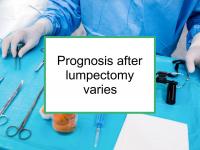A new study has reported that age and breast cancer subtype continue to influence prognosis after breast conserving treatment. Young breast cancer patients treated with breast-conserving therapy have been reported to have significant rates of local recurrence (i.e., in the same breast, chest wall, or lymph nodes).
The study included 1,434 consecutive patients with invasive breast cancer who were treated in Boston with breast-conserving therapy between December 1997 and July 2006. The patients were followed for a median of 85 months. Ninety-one percent of the women received systemic therapy after surgery. However, none received trastuzumab (Herceptin), which means that the recurrence rates reported in the study for HER2-positive (HER2+) breast cancer are higher than current rates.
Five molecular breast cancer phenotypes were approximated: luminal A (estrogen receptor positive (ER+) or progesterone receptor positive (PR+), HER2 negative (HER2-), and tumor grade 1 or 2); luminal B (ER+ or PR+, HER2-, and grade 3); luminal HER2+ (ER+ or PR+, and HER2+); HER2+ (ER-, PR-, and HER2+); and triple negative (ER-, PR-, and HER2-). Molecular phenotypes are a new way to categorize breast cancer into subtypes using gene expression profiling. Since gene expression profiling is not available for most breast cancer patients, study authors tend to approximate the phenotypes using hormone receptor status and other data that is available from routine pathology.
The five-year cumulative rate of local recurrence was 2.1% for the entire study population. When the data was stratified by age at diagnosis, the five-year rate of local recurrence was found to be 5.0% for ages 23 to 46 years; 2.2% for ages 47 to 54; 0.9% for ages 55 to 63; and 0.6% for ages 64 to 88 years. When the data was stratified by breast cancer phenotype, the five-year cumulative rate of local recurrence was found to be 0.8% for luminal A; 2.3% for luminal B; 1.1% for luminal HER2+; 10.8% for HER2+; and 6.7% for triple negative. Based on multivariable analysis, increasing age was associated with decreased risk of local recurrence. The authors conclude that, in the era of systemic therapy and breast cancer subtyping, age remains an independent prognostic factor after breast-conserving treatment. However, the risk of local recurrence for young women appears acceptably low.
Please see the following articles on prognosis for more information: ER+/PR+, mixed hormone receptor , HER2+, triple negative , breast cancer in very young women and breast cancer in old age.
